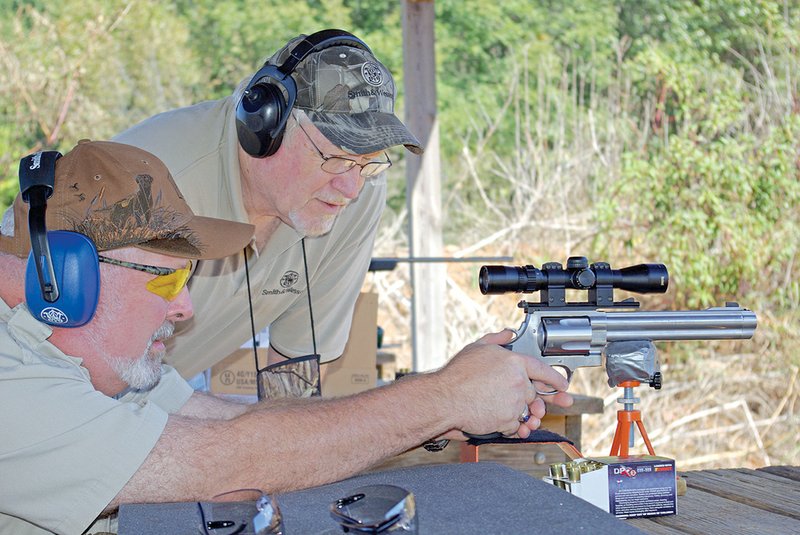The forested bottomlands along the lower White River in southeastern Arkansas are full of squirrels. I’ve hunted fox squirrels and gray squirrels in these woodlands for years. But this day, there was a new twist to my hunt. Instead of a rifle or shotgun, I was hunting with a .22 handgun.
“I’m glad we don’t have to rely on what we kill for our supper,” I said to my hunting companion, Lewis Peeler. “Otherwise, we might go hungry tonight.”
“I’m hungry already,” my son Matt added. “So I hope someone manages to kill something.”
When hunting river-bottom bushytails, we usually look for nut-bearing trees along old logging roads, bayous or oxbow lakes, then sit and watch for squirrels. That was our plan this day as we split up to hunt.
I consider myself a competent pistol shooter and squirrel hunter, but I figured this hunt would be difficult. I had little practice with my new handgun. There were plenty of squirrels there; I saw 12 in two hours. They were skittish, however, and feeding on acorns high in the trees.
The handgun I had chosen is a top-of-the-line target pistol: a Smith & Wesson Model 41 .22-caliber autoloader outfitted with a Bushnell 1X handgun scope with an illuminated dot reticle. But fancy equipment can’t compensate for my lack of practice. Twice, I centered the scope’s red dot on a squirrel’s head. Twice, the squirrel escaped unscathed. My woodsmanship wasn’t what it ought to be, either. The other 10 squirrels scampered away before I was close enough for a shot.
Lewis and Matt are better marksmen. When we rendezvoused at our appointed meeting place, Matt had a gray squirrel dangling from his belt. Lewis had two — a fox and a gray.
“I don’t know how the cowboys in the Old West did it with their handguns,” Matt said. “Guess we wouldn’t go hungry, but it’s a challenging way to hunt.”
“It’s a good thing we aren’t cowboys,” Lewis said. “If we had to face an outlaw for a shootout in the street, we might wake up dead. I count three squirrels, and I heard at least a dozen shots.”
“Must have been Dad shooting,” Matt said, grinning.
The first time I hunted with a handgun was on another squirrel hunt near Muskogee, Okla. The public-relations staff at Smith & Wesson had invited me to join several other writers to give handgun hunting a try during spring squirrel season, and while woods hunting proved difficult, several in our group hunted in a pecan orchard where they had better luck. The three of them managed to kill nine “limb chickens.”
“Pecan groves are ideal for handgun hunting,” said Ken Jorgensen with Smith & Wesson. “There’s no understory to contend with, so you have more open shots. And the trees often are full of squirrels that congregate to eat the pecans. We couldn’t have asked for a better handgun-hunting situation, though admittedly, we missed our share, too.”
“It’s fun, though,” said Bill Scherman of Muskogee, who also hunted with us. “And I intend to try it again. With some practice, I might be able to kill more.”
Despite the enthusiasm of a small but devoted group of followers, hunting squirrels with a handgun remains pretty esoteric business. Its satisfactions are great, but its practitioners are few.
Handgun hunting for other game, however, is a growing phenomenon. More hunters are going afield with handguns every year, more states allow handguns to be used on big game, and better products are making it feasible.
Handgun hunting appeals to a variety of sportsmen. There’s the hunter who has taken all sorts of game with rifles and wants to try something new. It’s for black-powder and archery hunters who can employ their stalking ability for a successful handgun hunt. Serious handgun shooters and competitors who are proficient on the range are applying their handgun skills in woods and fields.
The handgun of choice should be capable of accomplishing the task at hand but also one with which you’re comfortable and can develop adequate marksmanship skills. A .44-magnum revolver, for example, can deliver the accuracy and power needed to take deer, antelope, wild boar or even elk. A .357 Magnum can be relied upon to take many game animals if the distance is reasonable, and shot placement is precise. A friend of mine used a .41 Magnum to kill two deer last year and was pleased with the performance. He noted it was more pleasant to shoot than some .44s and certainly did the job.
Twenty-two-caliber pistols and revolvers are ideal hunting handguns for squirrels and rabbits. They’re fun to shoot, inexpensive and also make great practice firearms. You can put hundreds of rounds downrange for a few dollars while you learn sight alignment, trigger control and other basics.
Choosing proper ammo is also essential. There are many new and improved bullet designs marketed today. It used to be you made a choice between expansion and penetration, but that’s no longer the case. Today’s ammunition is better at providing both, and there’s a factory load for every quarry. Consult ammunition guides and other hunters for help in making a decision.
After equipment is chosen, the important work begins. The three most important things for a handgun hunter are practice, practice and more practice. Shooting a handgun accurately, especially at the distances many times needed in hunting situations, takes lots of practice. You must be good enough to hit your target when it counts.
Handgun hunting is a challenge worth pursuing. Cover the basics, develop your skills through practice, and you’ll find the sense of accomplishment in a successful handgun hunt is well worth the effort and discipline.
